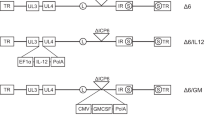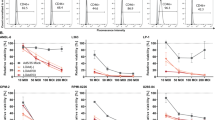Abstract
Direct viral infection of solid tumors can cause tumor cell death, but these techniques offer the opportunity to express exogenous factors to enhance the antitumor response. We investigated the antitumor effects of a herpes simplex virus (HSV) amplicon expressing mouse granulocyte–macrophage colony-stimulating factor (mGM-CSF) using the replication-competent HSV type 1 mutant HF10 as a helper virus. HF10-packaged mGM-CSF-expressing amplicon (mGM-CSF amplicon) was used to infect subcutaneously inoculated murine colorectal tumor cells (CT26 cells) and the antitumor effects were compared to tumors treated with only HF10. The mGM-CSF amplicon efficiently replicated in CT26 cells with similar oncolytic activity to HF10 in vitro. However, when mice subcutaneously inoculated with CT26 cells were intratumorally injected with HF10 or mGM-CSF amplicon, greater tumor regression was seen in mGM-CSF amplicon-treated animals. Furthermore, mGM-CSF amplicon treatment prolonged mouse survival. Immunohistochemical analysis revealed increased inflammatory cell infiltration in the solid tumor in the mGM-CSF amplicon-treated animals. These results suggest that expression of GM-CSF enhances the antitumor effects of HF10, and HF10-packaged GM-CSF-expressing amplicon is a promising agent for the treatment of subcutaneous tumors.
This is a preview of subscription content, access via your institution
Access options
Subscribe to this journal
Receive 12 print issues and online access
$259.00 per year
only $21.58 per issue
Buy this article
- Purchase on Springer Link
- Instant access to full article PDF
Prices may be subject to local taxes which are calculated during checkout





Similar content being viewed by others
References
Chiocca EA . Oncolytic viruses. Nat Rev Cancer 2002; 2: 938–950.
Varghese S, Rabkin SD . Oncolytic herpes simplex virus vectors for cancer virotherapy. Cancer Gene Ther 2002; 9: 967–978.
Nishiyama Y . Herpes simplex virus gene products: the accessories reflect her lifestyle well. Rev Med Virol 2004; 14: 33–46.
Markert JM, Medlock MD, Rabkin SD, Gillespie GY, Todo T, Hunter WD et al. Conditionally replicating herpes simplex virus mutant, G207 for the treatment of malignant glioma: results of a phase I trial. Gene Therapy 2000; 867–874.
Rampling R, Cruickshank G, Papanastassiou V, Nicoll J, Hadley D, Brennan D et al. Toxicity evaluation of replication-competent herpes simplex virus (ICP 34.5 null mutant 1716) in patients with recurrent malignant glioma. Gene Therapy 2000; 7: 859–866.
Papanastassiou V, Rampling R, Fraser M, Petty R, Hadley D, Nicoll J et al. The potential for efficacy of the modified (ICP 34.5(−)) herpes simplex virus HSV1716 following intratumoural injection into human malignant glioma: a proof of principle study. Gene Therapy 2002; 9: 398–406.
MacKie RM, Stewart B, Brown SM . Intralesional injection of herpes simplex virus 1716 in metastatic melanoma. Lancet 2001; 357: 525–526.
Harrow S, Papanastassiou V, Harland J, Mabbs R, Petty R, Fraser M et al. HSV1716 injection into the brain adjacent to tumour following surgical resection of high-grade glioma: safety data and long-term survival. Gene Therapy 2004; 11: 1648–1658.
Shah AC, Benos D, Gillespie GY, Markert JM . Oncolytic viruses: clinical applications as vectors for the treatment of malignant gliomas. J Neurooncol 2003; 65: 203–226.
Toyoizumi T, Mick R, Abbas AE, Kang EH, Kaiser LR, Molnar-Kimber KL . Combined therapy with chemotherapeutic agents and herpes simplex virus type 1 ICP34.5 mutant (HSV-1716) in human non-small cell lung cancer. Hum Gene Ther 1999; 10: 3013–3029.
Cinatl Jr J, Cinatl J, Michaelis M, Kabickova H, Kotchetkov R, Vogel JU et al. Potent oncolytic activity of multimutated herpes simplex virus G207 in combination with vincristine against human rhabdomyosarcoma. Cancer Res 2003; 63: 1508–1514.
Bennett JJ, Adusumilli P, Petrowsky H, Burt BM, Roberts G, Delman KA et al. Up-regulation of GADD34 mediates the synergistic anticancer activity of mitomycin C and a gamma134.5 deleted oncolytic herpes virus (G207). FASEB J 2004; 18: 1001–1003.
Nakano K, Todo T, Zhao G, Yamaguchi K, Kuroki S, Cohen JB et al. Enhanced efficacy of conditionally replicating herpes simplex virus (G207) combined with 5-fluorouracil and surgical resection in peritoneal cancer dissemination models. J Gene Med 2005; 7: 638–648.
Advani SJ, Sibley GS, Song PY, Hallahan DE, Kataoka Y, Roizman B et al. Enhancement of replication of genetically engineered herpes simplex viruses by ionizing radiation: a new paradigm for destruction of therapeutically intractable tumors. Gene Therapy 1998; 5: 160–165.
Kim SH, Wong RJ, Kooby DA, Carew JF, Adusumilli PS, Patel SG et al. Combination of mutated herpes simplex virus type 1 (G207 virus) with radiation for the treatment of squamous cell carcinoma of the head and neck. Eur J Cancer 2005; 41: 313–322.
Bradley JD, Kataoka Y, Advani S, Chung SM, Arani RB, Gillespie GY et al. Ionizing radiation improves survival in mice bearing intracranial high-grade gliomas injected with genetically modified herpes simplex virus. Clin Cancer Res 1999; 5: 1517–1522.
Blank SV, Rubin SC, Coukos G, Amin KM, Albelda SM, Molnar-Kimber KL . Replication-selective herpes simplex virus type 1 mutant therapy of cervical cancer is enhanced by low-dose radiation. Hum Gene Ther 2002; 13: 627–639.
Iizuka Y, Suzuki A, Kawakami Y, Toda M . Augmentation of antitumor immune responses by multiple intratumoral inoculations of replication-conditional HSV and interleukin-12. J Immunother 2004; 27: 92–98.
Ali SA, Lynam J, McLean CS, Entwisle C, Loudon P, Rojas JM et al. Tumor regression induced by intratumor therapy with a disabled infectious single cycle (DISC) herpes simplex virus (HSV) vector, DISC/HSV/murine granulocyte–macrophage colony-stimulating factor, correlates with antigen-specific adaptive immunity. J Immunol 2002; 168: 3512–3519.
Ahmad M, Rees RC, McArdle SE, Li G, Mian S, Entwisle C et al. Regulation of CTL responses to MHC-restricted class I peptide of the gp70 tumour antigen by splenic parenchymal CD4+ T cells in mice failing immunotherapy with DISC-mGM-CSF. Int J Cancer 2005; 115: 951–959.
Liu BL, Robinson M, Han ZQ, Branston RH, English C, Reay P et al. ICP34.5 deleted herpes simplex virus with enhanced oncolytic, immune stimulating, and anti-tumour properties. Gene Therapy 2003; 10: 292–303.
Herrlinger U, Jacobs A, Quinones A, Woiciechowsky C, Sena-Esteves M, Rainov NG et al. Helper virus-free herpes simplex virus type 1 amplicon vectors for granulocyte–macrophage colony-stimulating factor-enhanced vaccination therapy for experimental glioma. Hum Gene Ther 2000; 11: 1429–1438.
Toda M, Martuza RL, Rabkin SD . Tumor growth inhibition by intratumoral inoculation of defective herpes simplex virus vectors expressing granulocyte–macrophage colony-stimulating factor. Mol Ther 2000; 2: 324–329.
Carew JF, Kooby DA, Halterman MW, Kim SH, Federoff HJ, Fong Y . A novel approach to cancer therapy using an oncolytic herpes virus to package amplicons containing cytokine genes. Mol Ther 2001; 4: 250–256.
Zager JS, Delman KA, Malhotra S, Ebright MI, Bennett JJ, Kates T et al. Combination vascular delivery of herpes simplex oncolytic viruses and amplicon mediated cytokine gene transfer is effective therapy for experimental liver cancer. Mol Med 2001; 7: 561–568.
Link CJ, Vahanian NN, Wang S . Herpes simplex amplicon vectors. Methods Mol Med 2003; 76: 61–87.
Spaete RR, Frenkel N . The herpes simplex virus amplicon: a new eucaryotic defective-virus cloning-amplifying vector. Cell 1982; 30: 295–304.
Steinman RM . The dendritic cell system and its role in immunogenicity. Annu Rev Immunol 1991; 9: 271–296.
Pardoll DM . Paracrine cytokine adjuvants in cancer immunotherapy. Annu Rev Immunol 1995; 13: 399–415.
Takakuwa H, Goshima F, Nozawa N, Yoshikawa T, Kimata H, Nakao A et al. Oncolytic viral therapy using a spontaneously generated herpes simplex virus type 1 variant for disseminated peritoneal tumor in immunocompetent mice. Arch Virol 2003; 148: 813–825.
Kimata H, Takakuwa H, Goshima F, Teshigahara O, Nakao A, Kurata T et al. Effective treatment of disseminated peritoneal colon cancer with new replication-competent herpes simplex viruses. Hepatogastroenterology 2003; 50: 961–966.
Kohno S, Luo C, Goshima F, Nishiyama Y, Sata T, Ono Y . Herpes simplex virus type 1 mutant HF10 oncolytic viral therapy for bladder cancer. Urology 2005; 66: 1116–1121.
Teshigahara O, Goshima F, Takao K, Kohno S, Kimata H, Nakao A et al. Oncolytic viral therapy for breast cancer with herpes simplex virus type 1 mutant HF 10. J Surg Oncol 2004; 85: 42–47.
Sugiura S, Goshima F, Takakuwa H, Sata T, Nakashima T, Nishiyama Y . Treatment of solid sarcomas in immunocompetent mice with novel, oncolytic herpes simplex viruses. Otolaryngol Head Neck Surg 2004; 130: 470–478.
Nakao A, Kimata H, Imai T, Kikumori T, Teshigahara O, Nagasaka T et al. Intratumoral injection of herpes simplex virus HF10 in recurrent breast cancer. Ann Oncol 2004; 15: 988–989.
Wong RJ, Patel SG, Kim S, DeMatteo RP, Malhotra S, Bennett JJ et al. Cytokine gene transfer enhances herpes oncolytic therapy in murine squamous cell carcinoma. Hum Gene Ther 2001; 12: 253–265.
Bennett JJ, Malhotra S, Wong RJ, Delman K, Zager J, St-Louis M et al. Interleukin 12 secretion enhances antitumor efficacy of oncolytic herpes simplex viral therapy for colorectal cancer. Ann Surg 2001; 233: 819–826.
Parker JN, Gillespie GY, Love CE, Randall S, Whitley RJ, Markert JM . Engineered herpes simplex virus expressing IL-12 in the treatment of experimental murine brain tumors. Proc Natl Acad Sci USA 2000; 97: 2208–2213.
Dranoff G, Jaffee E, Lazenby A, Golumbek P, Levitsky H, Brose K et al. Vaccination with irradiated tumor cells engineered to secrete murine granulocyte–macrophage colony-stimulating factor stimulates potent, specific, and long-lasting anti-tumor immunity. Proc Natl Acad Sci USA 1993; 90: 3539–3543.
Stavropoulos TA, Strathdee CA . An enhanced packaging system for helper-dependent herpes simplex virus vectors. J Virol 1998; 72: 7137–7143.
Dix RD, McKendall RR, Baringer JR . Comparative neurovirulence of herpes simplex virus type 1 strains after peripheral or intracerebral inoculation of BALB/c mice. Infect Immun 1983; 40: 103–112.
Schröder CH, Kümel G . Virulent and Avirulent HSV-1: Pathogenesis and Molecular Biology. Raven Press: New York, 1986.
Jiang YM, Daikoku T, Yamamoto M, Morishima T, Nishiyama Y . Growth and cytopathogenicity of herpes simplex virus in a macrophage cell line, RAW264: a good indicator of intraperitoneal pathogenicity. Microbiol Immunol 1995; 39: 905–909.
Becker Y, Hadar J, Tabor E, Ben-Hur T, Raibstein I, Rosen A et al. A sequence in HpaI-P fragment of herpes simplex virus-1 DNA determines intraperitoneal virulence in mice. Virology 1986; 149: 255–259.
Berkowitz C, Moyal M, Rosen-Wolff A, Darai G, Becker Y . Herpes simplex virus type 1 (HSV-1) UL56 gene is involved in viral intraperitoneal pathogenicity to immunocompetent mice. Arch Virol 1994; 134: 73–83.
Koshizuka T, Goshima F, Takakuwa H, Nozawa N, Daikoku T, Koiwai O et al. Identification and characterization of the UL56 gene product of herpes simplex virus type 2. J Virol 2002; 76: 6718–6728.
Toda M, Rabkin SD, Kojima H, Martuza RL . Herpes simplex virus as an in situ cancer vaccine for the induction of specific anti-tumor immunity. Hum Gene Ther 1999; 10: 385–393.
Acknowledgements
We thank Dr Yoshinaga Saeki (Molecular Neuro-Oncology Laboratories, Neurosurgical Service, Massachusetts General Hospital, Charlestown, MA) for his generous gift of HSV amplicon pHGCX.
Author information
Authors and Affiliations
Corresponding author
Rights and permissions
About this article
Cite this article
Kohno, Si., Luo, C., Nawa, A. et al. Oncolytic virotherapy with an HSV amplicon vector expressing granulocyte–macrophage colony-stimulating factor using the replication-competent HSV type 1 mutant HF10 as a helper virus. Cancer Gene Ther 14, 918–926 (2007). https://doi.org/10.1038/sj.cgt.7701070
Received:
Revised:
Accepted:
Published:
Issue Date:
DOI: https://doi.org/10.1038/sj.cgt.7701070
Keywords
This article is cited by
-
Oncolytic activity of HF10 in head and neck squamous cell carcinomas
Cancer Gene Therapy (2020)
-
Combined therapy with CTL cells and oncolytic adenovirus expressing IL-15-induced enhanced antitumor activity
Tumor Biology (2015)
-
A phase I dose-escalation clinical trial of intraoperative direct intratumoral injection of HF10 oncolytic virus in non-resectable patients with advanced pancreatic cancer
Cancer Gene Therapy (2011)
-
Oncolytic and immunostimulatory efficacy of a targeted oncolytic poxvirus expressing human GM-CSF following intravenous administration in a rabbit tumor model
Cancer Gene Therapy (2010)
-
Abnormal expression of TRIB3 in colorectal cancer: a novel marker for prognosis
British Journal of Cancer (2009)



